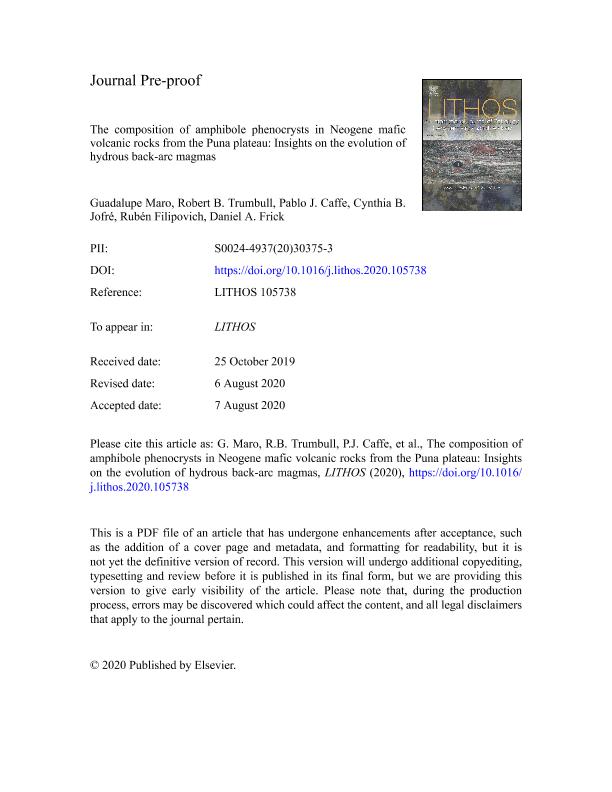Mostrar el registro sencillo del ítem
dc.contributor.author
Maro, Guadalupe

dc.contributor.author
Trumbull, Robert

dc.contributor.author
Caffe, Pablo Jorge

dc.contributor.author
Jofré, Cynthia Betina

dc.contributor.author
Filipovich, Ruben Eduardo

dc.contributor.author
Frick, Daniel A.
dc.date.available
2021-09-10T16:20:53Z
dc.date.issued
2020-12-01
dc.identifier.citation
Maro, Guadalupe; Trumbull, Robert; Caffe, Pablo Jorge; Jofré, Cynthia Betina; Filipovich, Ruben Eduardo; et al.; The composition of amphibole phenocrysts in Neogene mafic volcanic rocks from the Puna plateau: Insights on the evolution of hydrous back-arc magmas; Elsevier Science; Lithos; 376-377; 105738; 1-12-2020; 1-63
dc.identifier.issn
0024-4937
dc.identifier.uri
http://hdl.handle.net/11336/140095
dc.description.abstract
In typical Andean arc magmas, amphibole appears as a phenocryst phase only after considerable differentiation. However, some near-primitive volcanic rocks (high-Mg andesites and basalts) from monogenetic centers in the Puna plateau of Argentina also contain amphibole phenocrysts, implying special conditions of hydrous magma generation in this back-arc setting. This study documents typical examples from Southern and Northern Puna regions and uses the major and trace-element compositions of amphibole to constrain a petrogenetic model for the hydrous magmas. There are significant differences in the nature of amphiboles and their host lavas depending on location of the volcanic centers in the Southern and the Northern Puna regions. In the Southern Puna, basaltic andesitic lavas have Sr/Y values >40 and amphiboles show skeletal forms and occur in an assemblage with olivine and pyroxene. The amphibole compositions are relatively Al- and Ti-poor compared to the Northern Puna. Thermobarometry indicates amphibole crystallization temperatures of 960–1000 °C at moderate pressure (< 5 kbar). In contrast, the mafic lavas from centers in the Northern Puna show Sr/Y ratios lower than 20 and amphiboles in these rocks coexist with a plagioclase-orthopyroxene assemblage. The Northern Puna amphiboles have higher Ti and Al contents than those in the southern region and the thermobarometry estimates imply generally higher crystallization temperatures (>1000 °C) and pressures (6–8 kbar). Furthermore, the chemical composition of amphibole phenocrysts in the Northern Puna Campo Negro center suggests an alkaline affinity of the parental magmas which, together with radiogenic isotope data from earlier studies, indicates a significant contribution of the enriched lithosphere in the magma source. The new data collectively suggest high pressure evolution of hydrous magmas in the Southern Puna, whereas the Northern Puna magmas underwent more differentiation at higher levels in the crust. This contrast in the evolution history of magmas below both regions can be connected with their position relative to partial melting zones in the mid-upper crust, which are larger and longer-lived in the north than in the south, thus favoring a slower ascent of magmas in that region.
dc.format
application/pdf
dc.language.iso
eng
dc.publisher
Elsevier Science

dc.rights
info:eu-repo/semantics/openAccess
dc.rights.uri
https://creativecommons.org/licenses/by-nc-sa/2.5/ar/
dc.subject
ALTIPLANO-PUNA MAGMA BODY
dc.subject
AMPHIBOLE
dc.subject
COPPER
dc.subject
THERMOBAROMETRY
dc.subject
TRACE ELEMENTS
dc.subject.classification
Geoquímica y Geofísica

dc.subject.classification
Ciencias de la Tierra y relacionadas con el Medio Ambiente

dc.subject.classification
CIENCIAS NATURALES Y EXACTAS

dc.title
The composition of amphibole phenocrysts in Neogene mafic volcanic rocks from the Puna plateau: Insights on the evolution of hydrous back-arc magmas
dc.type
info:eu-repo/semantics/article
dc.type
info:ar-repo/semantics/artículo
dc.type
info:eu-repo/semantics/publishedVersion
dc.date.updated
2021-09-07T13:53:25Z
dc.journal.volume
376-377
dc.journal.number
105738
dc.journal.pagination
1-63
dc.journal.pais
Países Bajos

dc.journal.ciudad
Amsterdam
dc.description.fil
Fil: Maro, Guadalupe. Universidad Nacional de Jujuy. Instituto de Ecorregiones Andinas. Consejo Nacional de Investigaciones Científicas y Técnicas. Centro Científico Tecnológico Conicet - Salta. Instituto de Ecorregiones Andinas; Argentina. Consejo Nacional de Investigaciones Científicas y Técnicas; Argentina
dc.description.fil
Fil: Trumbull, Robert. German Research Centre for Geosciences; Alemania
dc.description.fil
Fil: Caffe, Pablo Jorge. Universidad Nacional de Jujuy. Instituto de Ecorregiones Andinas. Consejo Nacional de Investigaciones Científicas y Técnicas. Centro Científico Tecnológico Conicet - Salta. Instituto de Ecorregiones Andinas; Argentina. Consejo Nacional de Investigaciones Científicas y Técnicas; Argentina
dc.description.fil
Fil: Jofré, Cynthia Betina. Universidad Nacional de Jujuy. Instituto de Ecorregiones Andinas. Consejo Nacional de Investigaciones Científicas y Técnicas. Centro Científico Tecnológico Conicet - Salta. Instituto de Ecorregiones Andinas; Argentina. Consejo Nacional de Investigaciones Científicas y Técnicas; Argentina
dc.description.fil
Fil: Filipovich, Ruben Eduardo. Consejo Nacional de Investigaciones Científicas y Técnicas. Centro Científico Tecnológico Conicet - Salta. Instituto de Bio y Geociencias del NOA. Universidad Nacional de Salta. Facultad de Ciencias Naturales. Museo de Ciencias Naturales. Instituto de Bio y Geociencias del NOA; Argentina
dc.description.fil
Fil: Frick, Daniel A.. German Research Centre for Geosciences; Alemania
dc.journal.title
Lithos

dc.relation.alternativeid
info:eu-repo/semantics/altIdentifier/doi/http://dx.doi.org/10.1016/j.lithos.2020.105738
dc.relation.alternativeid
info:eu-repo/semantics/altIdentifier/url/https://www.sciencedirect.com/science/article/abs/pii/S0024493720303753
Archivos asociados
